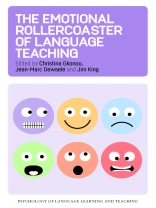This book focuses on the emotional complexity of language teaching and how the diverse emotions that teachers experience while teaching are shaped and function. The book is based on the premise that teaching is not just about the transmission of academic knowledge but also about inspiring students, building rapport with them, creating relationships based on empathy and trust, being patient and most importantly controlling one’s own emotions and being able to influence students’ emotions in a positive way. The book covers a range of emotion-related topics on both positive and negative emotions which are relevant to language teaching including emotional labour, burnout, emotion regulation, resilience, emotional intelligence and wellbeing among others. These topics are studied within a wide range of contexts such as teacher education programmes, tertiary education, CLIL and action research settings, and primary and secondary schools across different countries. The book will appeal to any student, researcher, teacher or policymaker who is interested in research on the psychological aspects of foreign language teaching.
Inhaltsverzeichnis
Tables, Figures and Images
Acknowledgements
Contributors
Jane Arnold: Foreword
Chapter 1. Christina Gkonou, Jean-Marc Dewaele and Jim King: Introduction to the Emotional Rollercoaster of Language Teaching
Chapter 2. Nicole Hofstadler, Kyle Talbot, Sarah Mercer and Anita Lämmerer: The Thrills and Ills of CLIL
Chapter 3. Kris Acheson and Robert Bruce Nelson: Utilising the Emotional Labour Scale to Analyse the Form and Extent of Emotional Labour among Foreign Language Teachers in the US Public School System
Chapter 4. Sarah Benesch: Theorising Emotions from a Critical Perspective: English Language Teachers’ Emotion Labour When Responding to Student Writing
Chapter 5. Emily Edwards and Anne Burns: ‘Opening Pandora’s Box’: Language Teachers’ Dynamic Emotional Experiences of Conducting Action Research
Chapter 6. Achilleas Kostoulas and Anita Lämmerer: Resilience in Language Teaching: Adaptive and Maladaptive Outcomes in Pre-service Teachers
Chapter 7. Joseph Falout: Past L2 Selves, Emotions and Classroom Group Dynamics: The Don’t Ask, Can’t Tell Policy
Chapter 8. Christina Gkonou and Elizabeth R. Miller: ‘Critical Incidents’ in Language Teachers’ Narratives of Emotional Experience
Chapter 9. Simon Humphries: “Please Teach Me How to Teach”: The Emotional Impact of Educational Change
Chapter 10. Maiko Ikeda, Osamu Takeuchi and Hiroyuki Imai: Investigating Dynamic Changes in Elementary School Teachers’ Anxiety when Teaching English
Chapter 11. Sam Morris and Jim King: Emotion Regulation among University EFL Teachers in Japan: The Dynamic Interplay between Context and Emotional Behaviour
Chapter 12. Peter I. de Costa, Wendy Li and Hima Rawal: Should I Stay or Leave? Exploring L2 Teachers’ Profession from an Emotionally-inflected Framework
Chapter 13. Tammy Gregersen, Peter D. Mac Intyre, & Nicole Macmillan: Dealing with the Emotions of Teaching Abroad: Searching for Silver Linings in a Difficult Context
Chapter 14. Rebecca Oxford: The Well of Language Teachers’ Emotional Well-Being
Chapter 15. Jean-Marc Dewaele: What Psychological, Linguistic and Sociobiographical Variables Power EFL/ESL Teachers’ Motivation?
Chapter 16. Jim King, Christina Gkonou and Jean-Marc Dewaele: Concluding Thoughts on the Emotional Rollercoaster of Language Teaching
Index
Über den Autor
Jim King is based at the University of Leicester where he directs the institution’s campus-based postgraduate courses in applied linguistics and teaching English as a second language. His books include the monograph Silence in the Second Language Classroom (Palgrave Macmillan, 2013) and the edited volumes The Dynamic Interplay between Context and the Language Learner (Palgrave Macmillan, 2015), The Emotional Rollercoaster of Language Teaching (with Christina Gkonou and Jean-Marc Dewaele, Multilingual Matters, 2020) and East Asian Perspectives on Silence in English Language Education (with Seiko Harumi, Multilingual Matters, 2020).












